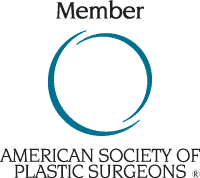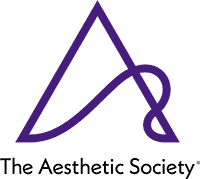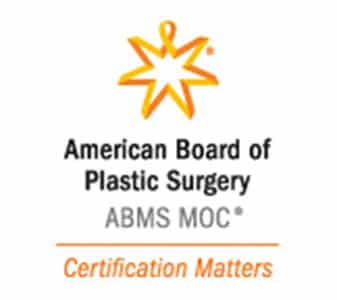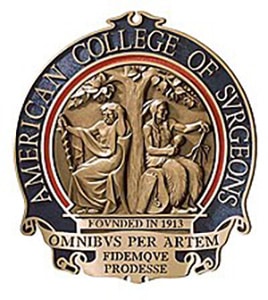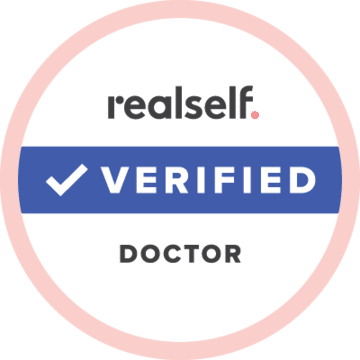
Breast Augmentation surgery involves using implants to enlarge the size of the breasts or restore fullness and volume that has been lost after pregnancy or weight loss. Many women who are unhappy with the size and shape of their breasts may benefit from Breast Augmentation surgery. Dr. Christopoulos uses both saline and silicone implants to provide a fuller and more shapely silhouette while improving overall breast contour.
If you have severely drooping breasts, a breast augmentation can be combined with a breast lift in order to improve the overall result. This is seen more often in women after pregnancy or weight loss where the combination of loss of breast volume and stretched out skin create drooping and deflated breasts. A breast lift can be performed in conjunction with a breast augmentation, or less frequently, as a separate procedure.
During your initial consultation, Dr. Christopoulos will discuss all of your options with you, including type of implant (saline vs. silicone), location of implant ( fully under the pectoralis muscle, partially under the muscle, or above the muscle), as well as location of incision (under the breast or inframammary, around the areola, or in the armpit).
Click Here for Before and After Pictures
Ideal candidates for Breast Augmentation surgery are patients who wish to:
Increase the overall size and projection of the breasts
Correct naturally occurring breast asymmetries that may be present
Restore volume and fullness that was lost during pregnancy or weight loss
Improve the overall balance and shape of your figure
About the Procedure
Dr. Christopoulos performs her surgeries in a fully accredited outpatient surgical facility. The procedure can take anywhere from 1-2 hours, depending on which procedure, or combination of procedures you are having performed.
Anesthesia
Dr. Christopoulos, in conjunction with an anesthesiologist, will use either intravenous sedation or general anesthesia to keep you comfortable and safe during your procedure.
Incisions and Implant Placement
Incisions are placed in inconspicuous areas on the breast to minimize visible scarring. These include under the breast (inframammary), around the areola, or in a skin crease of the armpit (transaxillary). Dr. Christopoulos will guide you through the decision making process to determine the most appropriate incision for you, based upon your anatomy, size and type of implant chosen, and desired outcome.
Implants can be placed under the pectoralis muscle (either completely or partially) or on top of the muscle. There are certain advantages to placement under the muscle such as reduced risk of capsular contracture (scar tissue and tightening that can form around the implant), less interference with mammography, and less visible rippling or wrinkling of the implants. Placement of implants on top of the muscle is also advantageous in certain women. Dr. Christopoulos will go over all of your options with you and determine the best location for your goals and individual anatomy.
Type of Implant
Saline and silicone breast implants differ in their characteristics, feel, and appearance. Both types of implants are safe and each offers its own advantages. Saline breast implants are filled with sterile saltwater and are filled after inserting the implant into the body. They tend to feel firmer and should a saline implant leak, the implant will collapse and the body will naturally absorb the saline fluid. Saline implants are FDA-approved for breast augmentation in women age 18 or older. Silicone breast implants are prefilled with a silicone gel that is thick and more resembles the feel of natural breast tissue. Should a silicone implant leak, the gel may leak into the breast implant pocket surrounding the implant; the implant does not collapse. Silicone implants are FDA-approved for breast augmentation on women age 22 or over.
Recovery and Results
The length of recovery depends on the type of procedure you have performed and the healing process does vary from individual to individual. It is natural to expect some bruising, swelling and numbness after your procedure. Most patients are able to resume daily activities within a few days and most can return to work within one week. Dr. Christopoulos will advise you to refrain from strenuous activity for several weeks after your surgery and will also guide you on the proper type of bra to wear as well as the proper massage techniques that are part of the healing process. Schedule a consultation today with Dr. Christopoulos to discuss further any questions you may have and to determine what type of breast augmentation is correct for you.
Frequently Asked Questions About Breast Augmentation Surgery
Breast augmentation surgery is a popular cosmetic procedure that enhances the size and shape of a person’s breasts. If you’re considering breast augmentation in Chicago, IL or have questions about the procedure, you’re not alone. Here are five frequently asked questions about breast augmentation surgery, along with detailed answers:
What Is Breast Augmentation Surgery, And How Is It Performed?
Breast augmentation, also known as augmentation mammoplasty, is a surgical procedure that involves increasing the size and enhancing the shape of the breasts. The surgery is typically performed under general anesthesia and involves the following steps:
- Incision: The surgeon makes an incision, usually in the crease under the breast, around the areola (the dark area around the nipple), or in the armpit.
- Implant Placement: The surgeon creates a pocket either under the breast tissue or behind the chest muscle (submuscular placement) to accommodate the breast implant.
- Implant Insertion: The breast implant, typically filled with saline or silicone gel, is carefully inserted into the pocket.
- Closing Incisions: The surgeon closes the incisions with sutures or surgical tape, and the incision sites are covered with sterile dressings.
- Breast augmentation can achieve various goals, including increasing breast size, improving symmetry, restoring breast volume lost due to pregnancy or weight loss, and enhancing overall breast shape.
What Are The Different Types Of Breast Implants, And How Do I Choose The Right One?
There are two main types of breast implants: saline and silicone gel. Each has its advantages, and the choice depends on individual preferences and factors discussed with your plastic surgeon:
- Saline Implants: These implants are filled with sterile saline (saltwater) solution. They are inserted empty and then filled, allowing for minor adjustments in size during surgery. Saline implants are generally less expensive and, in the event of a rupture, the saline is harmlessly absorbed by the body.
- Silicone Gel Implants: These implants contain a silicone gel that closely mimics the feel of natural breast tissue. Silicone implants are pre-filled and often chosen for their natural look and texture. In case of a rupture, silicone gel may not be as noticeable as saline and typically stays within the implant’s shell.
Choosing the right type of implant involves considering factors like desired aesthetics, personal preferences, and your plastic surgeon’s recommendations. Your surgeon will discuss implant options, sizes, and shapes during the consultation to help you make an informed decision.
What Should I Expect During Recovery After Breast Augmentation Surgery?
Recovery after breast augmentation varies from person to person, but here are some general guidelines:
- Pain and Discomfort: Some discomfort, swelling, and bruising are common immediately after surgery. Pain medication prescribed by your surgeon can help manage any pain.
- Downtime: Most patients can return to light activities within a few days but should avoid strenuous exercise and heavy lifting for a few weeks.
- Follow-Up Appointments: You’ll have several follow-up appointments with your surgeon to monitor your progress and address any concerns.
- Scar Care: Incision scars will gradually fade over time, and your surgeon may recommend scar-minimizing treatments or creams.
- Supportive Garments: You may need to wear a supportive surgical bra or compression garment during the initial recovery period to minimize swelling and support the healing process.
- Swelling and Bruising: These side effects are temporary and should subside over the first few weeks.
Full recovery can take several weeks, and it’s essential to follow your surgeon’s post-operative instructions carefully to ensure optimal healing and results.
What Are The Risks And Potential Complications Of Breast Augmentation Surgery?
Breast augmentation surgery, like any surgical procedure, carries risks and potential complications. It’s important to be aware of these and discuss them with your plastic surgeon:
- Infection: Infections at the incision site are possible, although they are relatively rare.
- Implant Rupture: Implants can rupture or leak. Saline implants deflate visibly, while silicone gel implants may require imaging to detect a rupture.
- Capsular Contracture: Scar tissue can form around the implant, causing it to become firm or distorted.
- Changes in Sensation: Temporary changes in nipple sensation are common but can become permanent in rare cases.
- Unsatisfactory Aesthetic Outcomes: While most patients are satisfied with their results, there is a possibility of asymmetry, rippling, or other aesthetic issues.
- Revision Surgery: Breast implants are not lifelong devices, and additional surgery may be necessary for maintenance, replacement, or removal.
Your plastic surgeon will discuss these risks with you during the consultation and provide guidance on how to minimize them. It’s crucial to choose a board-certified plastic surgeon who prioritizes patient safety and follows best practices.
How Long Do Breast Implants Last, And What Is The Process For Removal Or Replacement?
Breast implants are not considered lifetime devices, and their longevity varies. While some implants may last for many years without issues, others may require replacement sooner. If you are not having issues with your implants, they do not need to be replaced at a specific time point.
The process for implant removal or replacement involves a surgical procedure similar to the initial
breast augmentation, or can be a more involved procedure if you need a breast lift or other
ancillary procedures. If you wish to have your implants removed or replaced, consult with dedicated board-certified plastic surgeon Niki Christopoulos, MD FACS to schedule a consultation.
Disclaimer: Dr. Niki Christopoulos & Christopoulos Plastic Surgery Chicago, IL Please remember that medical information provided by Dr. Niki Christopoulos & Christopoulos Plastic Surgery in the absence of a visit with a health care professional, must be considered as an educational service only. YOUR RESULTS WILL VARY. The information sent through e-mail should not be relied upon as a medical consultation. This mechanism is not designed to replace a physician’s independent judgement about the appropriateness or risks of a procedure for a given patient. We will do our best to provide you with information that will help you make your own health care decisions. Many external links have been provided on this site as a service and convenience to our patients and other visitors to our website. These external sites are created and maintained by other public and private organizations. We do not control or guarantee the accuracy, relevance, timeliness, or completeness of this outside information. If you require to find out more please email us on info@christopoulosplasticsurgery.com

